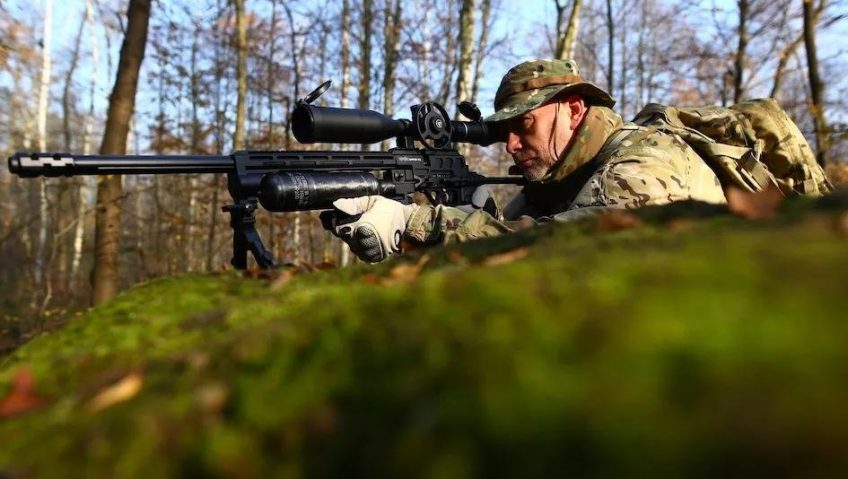What to target quickly and accurately. Among optics, we distinguish between two basic devices: a collimator and a telescope. First, ask yourself what you intend to put the optics on. On a pistol or on a rifle. Do you intend to shoot at short or long distances? What size is the target? If you are clear on all the questions, we can move on to choosing a sight.
1. COLLIMATORS
When aiming through a collimator, we use both eyes at the same time, so we have better orientation in the field, as a result of which grasping the target is simpler and faster than with a scope. This will be appreciated when shooting dynamically. In addition, the operation of the collimator is intuitive and fast. The collimator itself works on the principle of collimation, in practice, it looks like the emitter emits a narrow stream of light onto the lens.
The collimator will work well for larger targets at short distances. It is most often referred to in the context of a tactical sight. This is because it usually does not magnify the target, making it most suitable for pistols and tactical rifles like the Sig Sauer MPX.
CLOSED COLLIMATOR
This model looks like a scope but is significantly shorter. It is suitable for the already mentioned tactical weapons of the Sig Sauer MPX type, and this is due to its smaller field of view. The cheekpiece makes aiming through the eyepiece faster and more efficient.
OPEN COLLIMATOR
The point of light is emitted on the lens located at the front. This type is an ideal choice for a classic pistol. Thanks to the large field of view, the collimator does not need to be at an exact distance from the eye.
If you are thinking about a product that completely meets modern requirements, pay attention to the Valiant Micro PointSight Red Dot model. You will use one of the smallest models on the market on a windshield, but also on a weapon subject to registration. The manufacturer does not impose any caliber limits.
2. TELESCOPES
The choice of scopes is often downplayed. Many shooters, when investing in a gun, will go for inadequate optics. On our site you will find scopes with different designations like Valiant 4-16×50 SF SIR FBR. Let’s explain what the given numbers and letters mean.
MAGNIFICATION, ZOOM (ZOOM)
The Valiant 3-9×40 AOIR variant stands for 3-9x zoom. That is, the scope allows a maximum magnification of 9 times. This parameter is important when choosing. If you intend to shoot at long distances, a scope with higher numbers like the Valiant 5-20×50 will be a better choice.
Another subcategory is the Valiant 6×40, denoting a fixed 6x magnification. Thus, it is about a scope with fixed magnification without the possibility of adjustment. This type is preferred by shooters who practice shooting at a fixed distance.
PARALLAX CORRECTION
Generally speaking, parallax is used to sharpen the image of differently distant targets at different magnifications. One of the advantages of parallax is that adjusting it allows you to determine the distance of your target.
Parallax is usually labelled SF (Side Focus) or AO (Adjustable Objective). SF stands for side parallax adjustment located on the turret on the side of the scope. In the case of the AO designation, parallax adjustment takes the form of a ring located on the scope’s objective lens. The third group consists of scopes without parallax.
DIAMETER OF THE TUBE AND LENS
Spotting scopes are manufactured with two basic tubes of 25.4 mm (1″) and 30 mm in diameter. The first one tends to come in lower lines, which does not mean that it is inferior. The point is that some shooters prefer smaller dimensions and lower magnification. The second tube is abundant in higher lines. Its advantage lies in better light transmission, which provides a brighter image. On the downside, it is slightly heavier in weight.
The scope’s objective – the last digit in the designation – indicates the size of the exit pupil. In the case of Valiant 4-16×50 scopes, the diameter is 50 mm. The size of the lens affects the brightness of the image. The higher the digit, the more breaking beams of light, and thus the greater the sharpness of the image.
DIOPTRIC CORRECTION
This function is used by shooters with poor eyesight. It allows you to adjust the diopter within a certain range, thus removing the need to use glasses when aiming.
CROSSES
Crosshairs allow you to take an accurate shot. We can divide them into basic types.
Wire crosshairs
We can most often hit the wire reticle in conventional scopes of lower series.
Etched crosshairs
The etched reticle is etched directly on the glass. It is often found in scopes of higher series. Nowadays we have a veritable rash of models with an illuminated reticle, which makes it possible to shoot even at dusk, as it does not melt into the background. As a rule, the illumination is green or red in color and often has adjustable intensity.
VALIANT LUNETS
Manufacturers often customize crosshairs with user suggestions in mind. One of them is Valiant, whose range immediately includes two types designed according to the requirements of shooters. The first of these is called FBR. Its uniqueness lies in the elongated markers on the lower beam of the reticle, which translates into a greater ability to apply corrections at long distances.
The second type with the designation HFT was designed, as you can easily guess, for the HFT shooting discipline. This discipline involves shooting at targets located at an unknown distance to the shooter. Such a system will also find use during a recreational shooting in the comfort of our garden, where we also shoot at targets at different distances.
BEFORE BUYING AN OPTIC, ASK YOURSELF A FEW QUESTIONS
1. At what distance will you use the scope?
At distances of 10 to 15 m, it is not necessary to have an exaggerated magnification, a fixed 4×32 magnification is completely sufficient.
At various distances up to 30 m, a scope with variable magnification of 3-9×40 will be a good choice. It provides sufficient magnification.
If our ambitions exceed the limit of 30 m, it will be good to reach for one of the most popular variable magnifications 4-16×50.
2. What targets to shoot at?
Here it is similar to the question of shooting distance. Shooting at small targets requires a higher magnification.
3. What brands offer good quality?
Among the most popular brands is Nikko Stirling. It generally produces conventional scopes, but at the same time offers a premium series manufactured directly in Japan.
The Valiant company in recent years has presented scopes that stand out especially from the competition in terms of price-quality ratio. The quality of workmanship of the crosshairs and tubes etched on the glass matches the level of brands such as Hawke, Vortex, or Optisan. Valiant has built its scopes so that they can be used on any weapon regardless of caliber. The large selection of models and price range makes it possible for everyone to choose the most suitable model.
In addition, you will also find scopes from such global brands as Walther, Sightron, MTC, etc.
3. SCOPE MOUNTS
First, make sure what kind of mount is on the weapon. As a rule, windshields tend to have an 11mm rail. The next step will be to determine the height of the mount. Remember that the lens should be as close to the weapon as possible, so try to choose the lowest possible mount. Mount height is given in millimeters, with the height measured from the rail to the lower edge of the ring.
ONE-PIECE ASSEMBLY
It is recognizable at a glance. It has a monolithic design, which ensures stability on large caliber weapons.
TWO-PIECE MOUNT
It owes its popularity to its high versatility and low weight. It is an ideal choice for all kinds of air weapons that do not produce a large recoil. Spring-loaded windcheaters are a different case. Venox, which offers a wide range of mounts, is very popular among users.
It should be taken into account that some scopes are already complete with a mount from the factory, in which case we do not have to trouble ourselves with the choice.
































